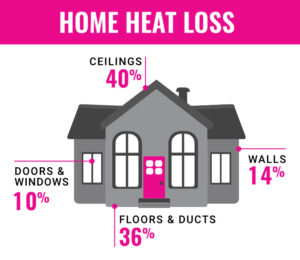Why Insulate? An Introduction to Insulation
Although insulation is an important part of every building, it is often the least understood. Many people aren’t aware of the many places where energy is lost in a home. As an Owens Corning® Certified Energy Expert® professional, Specialty Insulation understands the science behind the building envelope. So, you can turn to us to learn more about the benefits of insulation.
Insulation lays a foundation of energy efficiency for residential, commercial and industrial structures. It is one of the most cost effective ways to save energy and reduce monthly heating and cooling costs.
How Insulation Works
Heat flows from higher temperature areas to lower temperature areas, creating temperature fluctuation within a space. Insulation wraps your home in a protective blanket, reducing heat flow in order to keep the heat out during warmer months and the heat in during cooler months. Insulation is an excellent noise absorber and helps to reduce sound transmission from both outside and within a home, creating a quieter space with less reverberation. Insulation also allows other energy efficient components such as air sealing to do their job, forming a comprehensive insulating system that helps maintain consistent temperatures and moisture levels, reduce energy usage and increase monthly energy savings.
Benefits of Insulation
Whether you are remodeling a home or building a new business, there are many benefits of insulation.
Consistently improved year-round comfort indoors
Reduced energy usage
Lower heating and cooling costs
Less wear and tear on HVAC equipment
Reduced noise transmission for a quieter space
Improved air quality
Reduced moisture intrusion
Less overall environmental impact
What Is R-Value?
The “R” in R-value stands for resistance to heat flow. The higher the R-value, the higher the level of resistance and the greater the insulating power. R-value requirements vary depending on climate and building type.
Below is an example of how R-value relates to the amount of insulation used in a typical attic. The thicknesses listed are for Owens Corning® PROPINK® L77 PINK® FiberglasTM Unbonded Loosefill Insulation blown in the attic and not a general rule of thumb for any other brand/type of insulation in any other areas/applications. We can provide you with the correct amount of insulation for your project.
| R-value | Minimum Thickness (in) |
| R-13 | 4.75 |
| R-19 | 7.00 |
| R-22 | 8.00 |
| R-26 | 9.25 |
| R-30 | 10.50 |
| R-38 | 13.25 |
| R-44 | 15.00 |
| R-49 | 16.75 |
| R-60 | 20.00 |

How much insulation is enough?
The amount of insulation needed varies depending on location, building type, and materials. You can review this recommended R-value levels chart from ENERGY STAR. We will work with you to provide the right insulation estimate for your specifications.
Things to consider when insulating
- What type of insulation is being used?
- Does the insulation meet or exceed local building codes and national
recommended insulation levels? - How effective is the insulation (thermal performance, acoustical performance)?
- Is the insulation resistant to moisture, fire and settling?
- Is the insulation material safe and sustainable?
- Is the insulation cost effective?
your house as a system
Though insulation is one of the most essential and cost effective ways to create overall efficiency, there are many factors to take into consideration. Insulation and air sealing combined with energy efficient appliances, windows, doors, lighting and HVAC equipment build a whole-house efficiency system that will prove beneficial throughout the year and for years to come. We can provide an in-home consultation to help you create a plan to address any energy concerns in your household.
Where to Insulate
Insulation should be installed in the walls, floors, attic space, basement, and crawl space. A more detailed list includes.
Ceilings with unheated spaces above, including dormer ceilings
Knee walls of attic spaces finished as living areas.
Sloped walls and ceilings of attics finished as living areas.
Cathedral or vaulted ceilings
Around perimeters of slabs
Floors above vented crawl spaces
Basement walls
Band and header joists
Interior walls, ceilings, or floors where extra sound control is needed
Floors over unconditioned basements
Floors over unheated or open spaces such as over garages or porches
Mobile/manufactured home skirting
if you still have questions, we have answers!
Contact us today to learn more about the benefits of insulation.
